 Statue of Britannia.
Statue of Britannia.
How can there be any doubt? B is for Britannia, and there are a host of statues of Britannia all across the country. She is particularly popular on the top of a dome or otherwise against the skyline, or as a central figure in a pediment. Britannia is a strong muscular, feminine figure, typically mature, occasionally a more youthful girl. She is a warrior (indeed, four Britannias feature on the page on this site dedicated to Warrior Women). Her accoutrements are a trident, or sometimes a spear – occasionally originally a trident which has been replaced by a spear during restoration, also a shield, typically with the overlaying crosses of the Union Jack on it, but often not. She wears a helmet, usually Corinthian, often pushed up and back, as is not uncommonly shown for hoplites in ancient Greek friezes. She often wears chain or plate mail, and generally has a heavy cloak. She may be accompanied by a lion, or attendants.
The figure at the top of this page, and the one below, typify Britannia; in both these cases, she is seated on a lion, and has the full set of accoutrements noted above. Such figures, of greater or lesser size, are found in many UK towns. There is a whole page of lion sculptures here.
The example below left, an early example from Leeds, is a standing example, and as well as the lion, shows another not untypical adornment, in the lion clasp at her breast – think how many mildly adorned Victorian buildings have one or more similar little lion heads at first or second floor or attic level. The top of her shield bends outwards, reminding the viewer of the prow of a ship. Below right, this is taken a step further, with a rather unconventional Britannia standing on the small ship – this is Britain as a maritime power, and her cloak billows out behind her as if catching the sea breeze. (If you want more ship sculpture, see this page.) This sculpture is in Manchester. Note that she carries a peaceful wreath of olive leaves, rather than anything more aggressive, and this is unusual except in connection with memorials.
Britannia in Leeds and Manchester.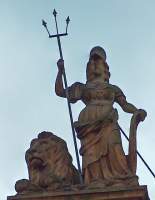
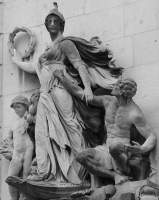
The Manchester example above is rather baroque in the treatment of pose and clothes. Below we have her antithesis – a more cool Classical figure with Hellenistic drapery, almost a demonstration piece for the different types of natural folds.
Many of our Britannias are anonymous in terms of their maker, but the example below left is a work of A. G. Lawson, a figure of Britannia from a frieze in Bath. Alas, she has suffered cruelly from pollution and wind, and perhaps over zealous cleaning, for the drapery has lost the subtlety and refinement we would associate with Lawson. Below right, we have the Harrods Britannia, a splendid example in terra cotta by the sculptor John Broad, with two attendants making offerings, and all her normal accoutrements –helmet, mail shirt, trident, thick cloak, and on the raised pillars on either side, little lions.
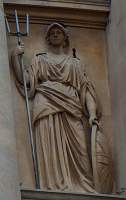
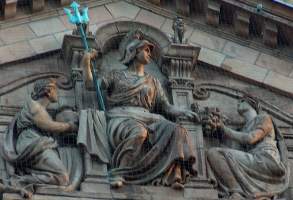 Britannia in Bath by Lawson, and at Harrods by John Broad.
Britannia in Bath by Lawson, and at Harrods by John Broad.
Below left is one of the most well-known Britannias - she is Britannia as Victory, holding a torch as well as her trident, with accompanying cherubs holding her wreath and part-furled flag. Her arms are muscular, and her face has the hard idealism of the early 20th Century. She is on Waterloo Station, as part of the World War 1 monument, and the sculptor is the all too rarely-encountered F. W. Doyle-Jones. The rather earlier example below right similarly has the physique of a wrestler, but despite this and her heavy sword and spiky crown, her face has a softness and almost a troubled look. Her wreath is of olive leaves, and the extra sprig in her hand reminds us she is here an emblem peace as well as war. On her shield is written Pro Patria.
Two more to end on a less familiar note. The figure below left is a Mourning Britannia, by a rather forgotten figure of the early 20th century, Clement Jewitt. She mourns for some deceased statesman, represented on a medallion at her feet, so this is presumably from some memorial piece. With the usual shield, sword, armour under her cloak and helmet - in this case recollecting Athena, she is unusually light of build, thin rather than warriorlike. Also rather slender for a Britannia is the figure below right, familiar to Liverpudlians, as the centrepiece of the World War 1 Memorial on Exchange Flags, Liverpool, by Joseph Philips. She haas a trident, a magnificently large cloak, and is the only Britannia I am aware of on public display who stands upon an artillery piece.

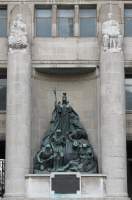 Mourning Britannia and the Liverpool Britannia triumphant in the WW1 memorial.
Mourning Britannia and the Liverpool Britannia triumphant in the WW1 memorial.
Allegorical sculpture - A // Allegorical sculpture - C // Full Alphabet of Allegorical sculpture
Sculpture in London // Sculpture in England // Sculptors
Visits to this page from 21 Nov 2011: 21,382